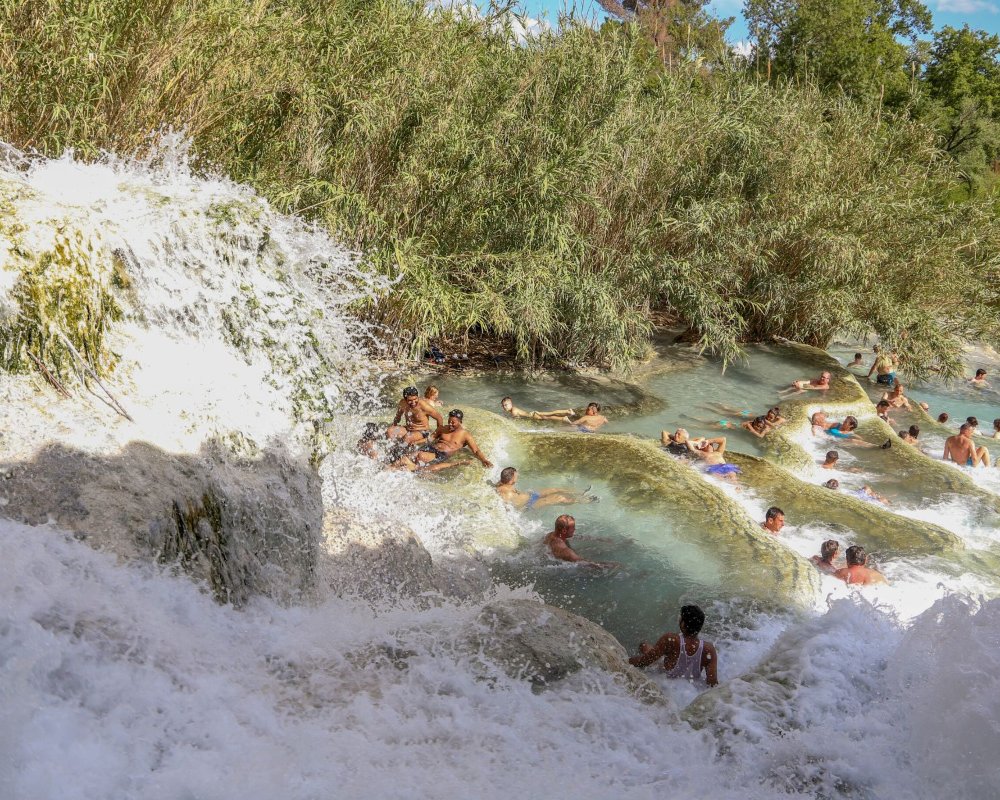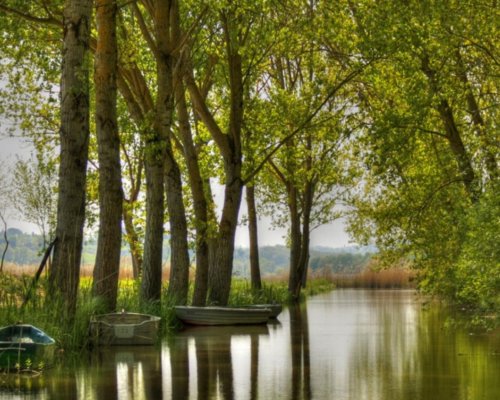An itinerary to naturally discover the Etruscans’ relationship with water, the principle of life and civilisation
Water, an irreplaceable element for all civilisations and essential in everyday life, was sacred and an object of worship for the Etruscans, as it is for other peoples. Retracing the waterways means walking in Etruscan footsteps to discover the most mysterious people of all. The stages below form an itinerary that explores the places where the Etruscans and other ancient populations exploited the precious thermal springs, the course of rivers, the banks of lakes and water reservoirs.
Underneath the ancient city of Chiusi, an intricate network of tunnels, which can be explored by visiting the Labyrinth of Porsenna or “The Underground City” Civic Museum, evidence of the capillary storage of water. Near the village, one can relax on the banks of the lake with the same name, enjoying a picturesque natural habitat, already known to the Etruscans who exploited its agricultural resources.
Underneath the ancient city of Chiusi, an intricate network of tunnels, which can be explored by visiting the Labyrinth of Porsenna or “The Underground City” Civic Museum, evidence of the capillary storage of water. Near the village, one can relax on the banks of the lake with the same name, enjoying a picturesque natural habitat, already known to the Etruscans who exploited its agricultural resources.
Also in the vicinity of the splendid town of Montepulciano is a lake basin of particular natural and landscape interest, the lake of Montepulciano. Some studies claim that it formed, together with that of Chiusi, a single lake in the Valdichiana, exploited since Etruscan times. Both lakes are now sites of community importance and are connected by the Sentiero della Bonifica (The Path of Reclaimed Land), an itinerary that can also be travelled by bicycle, extending over 60 km between Chiusi and Arezzo.
Also in the vicinity of the splendid town of Montepulciano is a lake basin of particular natural and landscape interest, the lake of Montepulciano. Some studies claim that it formed, together with that of Chiusi, a single lake in the Valdichiana, exploited since Etruscan times. Both lakes are now sites of community importance and are connected by the Sentiero della Bonifica (The Path of Reclaimed Land), an itinerary that can also be travelled by bicycle, extending over 60 km between Chiusi and Arezzo.
One of the most popular destinations for physical well-being, Chianciano Terme is surrounded by the stunning Valdichiana countryside and, in addition to beautiful landscapes and enchanting spas, it offers an opportunity to get to know the Etruscan civilisation better. It is home to a rich archaeological museum housed in an ancient 19th-century granary.
One of the most popular destinations for physical well-being, Chianciano Terme is surrounded by the stunning Valdichiana countryside and, in addition to beautiful landscapes and enchanting spas, it offers an opportunity to get to know the Etruscan civilisation better. It is home to a rich archaeological museum housed in an ancient 19th-century granary.
Immersed in the World Heritage landscapes of Val d'Orcia, Bagno Vignoni is a tiny but precious gem of history and thermal springs, where one can admire the extraordinary pool in the middle of the small town, still enriched by its thermal treasure trove exploited since Etruscan times and above all by the Romans.
Immersed in the World Heritage landscapes of Val d'Orcia, Bagno Vignoni is a tiny but precious gem of history and thermal springs, where one can admire the extraordinary pool in the middle of the small town, still enriched by its thermal treasure trove exploited since Etruscan times and above all by the Romans.
Used for thousands of years since Etruscan times, the small hot water pools of Bagni San Filippo are covered with magical, white limestone formations, such as the “White Whale”, the most spectacular of all, so named for its size and the concretions that resemble the great cetacean. Surrounded by the splendid hills of Castiglione d’Orcia and situated at the foot of the Amiata, its waters possess analgesic and anti-inflammatory properties and are freely accessible.
Used for thousands of years since Etruscan times, the small hot water pools of Bagni San Filippo are covered with magical, white limestone formations, such as the “White Whale”, the most spectacular of all, so named for its size and the concretions that resemble the great cetacean. Surrounded by the splendid hills of Castiglione d’Orcia and situated at the foot of the Amiata, its waters possess analgesic and anti-inflammatory properties and are freely accessible.
The nearby Sarteano also brims with Etruscan civilisation. Thermal mineral waters flow from this area and it is the setting for highly important archaeological testimonies, such as the Tomb of the Infernal Chariot, a sepulchre steeped in legend and artistic beauty and one of the most significant examples of Etruscan painting.
The nearby Sarteano also brims with Etruscan civilisation. Thermal mineral waters flow from this area and it is the setting for highly important archaeological testimonies, such as the Tomb of the Infernal Chariot, a sepulchre steeped in legend and artistic beauty and one of the most significant examples of Etruscan painting.
San Casciano dei Bagni holds a real Etruscan treasure. Right here recently, an incredible archaeological discovery was made: more than 20 Etruscan statues and other artifacts were extracted from the slime of the hot springs. The thermal baths of San Casciano and the therapeutic properties of its mineral-thermal waters have been known and exploited since ancient times, as they are today.
San Casciano dei Bagni holds a real Etruscan treasure. Right here recently, an incredible archaeological discovery was made: more than 20 Etruscan statues and other artifacts were extracted from the slime of the hot springs. The thermal baths of San Casciano and the therapeutic properties of its mineral-thermal waters have been known and exploited since ancient times, as they are today.
In the wild south of Maremma, the most famous thermal waters gush forth, giving life to the splendid and unmistakable landscape of the thermal baths of Saturnia. A site in the Manciano territory permeated with history and legends, it was considered a sacred place by the Etruscans. The freely accessibly thermal baths at the Mill Waterfalls (Cascate del Mulino) are considered the most beautiful natural thermal baths in the peninsula.
In the wild south of Maremma, the most famous thermal waters gush forth, giving life to the splendid and unmistakable landscape of the thermal baths of Saturnia. A site in the Manciano territory permeated with history and legends, it was considered a sacred place by the Etruscans. The freely accessibly thermal baths at the Mill Waterfalls (Cascate del Mulino) are considered the most beautiful natural thermal baths in the peninsula.
The area of the famous Terme San Giovanni thermal baths in Rapolano is not only a favourite place for relaxation and luxury. Artefacts dating back to Etruscan-Roman times were found nearby, specifically at Campo Muri. The area was later musealized, to make this archaeological heritage usable.
The area of the famous Terme San Giovanni thermal baths in Rapolano is not only a favourite place for relaxation and luxury. Artefacts dating back to Etruscan-Roman times were found nearby, specifically at Campo Muri. The area was later musealized, to make this archaeological heritage usable.
A world-famous pearl, San Gimignano stands in the valley created by the Elsa River, which turns a beautiful deep turquoise in some places. Behind the town's medieval facade lies a much older history, dating back to Etruscan times. Symbolic of its past is Hinthial, the Shadow of San Gimignano, a bronze votive statuette dated to the 3rd century B.C. discovered by chance in the surrounding countryside.
A world-famous pearl, San Gimignano stands in the valley created by the Elsa River, which turns a beautiful deep turquoise in some places. Behind the town's medieval facade lies a much older history, dating back to Etruscan times. Symbolic of its past is Hinthial, the Shadow of San Gimignano, a bronze votive statuette dated to the 3rd century B.C. discovered by chance in the surrounding countryside.
Included in the list of Italy's most beautiful towns, Montaione is an alluring medieval town set in the most beautiful Florentine countryside. The countryside is crossed by the Elsa River and is rich in Etruscan history, so much so that multiple rooms of the civic museum housed in the town's historic center have been set up for the many valuable artifacts found in the surrounding necropolis.
Included in the list of Italy's most beautiful towns, Montaione is an alluring medieval town set in the most beautiful Florentine countryside. The countryside is crossed by the Elsa River and is rich in Etruscan history, so much so that multiple rooms of the civic museum housed in the town's historic center have been set up for the many valuable artifacts found in the surrounding necropolis.
An ancient town in Valdera, Capannoli stands on the Era River and has an Etruscan heritage of considerable importance. The 18th-century Villa Baciocchi stands on the ancient remains of the castle, an excellent setting for the Archaeological Museum of Valdera which houses a rich collection of artefacts found in the area shaped by the Era River. Instead, the hamlet of San Pietro Belvedere is a true open-air museum which recounts its centrality in the Etruscan period.
An ancient town in Valdera, Capannoli stands on the Era River and has an Etruscan heritage of considerable importance. The 18th-century Villa Baciocchi stands on the ancient remains of the castle, an excellent setting for the Archaeological Museum of Valdera which houses a rich collection of artefacts found in the area shaped by the Era River. Instead, the hamlet of San Pietro Belvedere is a true open-air museum which recounts its centrality in the Etruscan period.
The Arno Valley on the outskirts of Florence has recently been enlivened by the debate “Is Signa an Etruscan or a Roman city?”. Studies and research have established its highly likely Etruscan origin, also considering that the Arno was used as a navigable river; built close to the Arno, Signa may have originated from an Etruscan settlement to exploit its natural harbour. Various theories therefore do not rule out the Etruscan origins of the Castle of Signa.
The Arno Valley on the outskirts of Florence has recently been enlivened by the debate “Is Signa an Etruscan or a Roman city?”. Studies and research have established its highly likely Etruscan origin, also considering that the Arno was used as a navigable river; built close to the Arno, Signa may have originated from an Etruscan settlement to exploit its natural harbour. Various theories therefore do not rule out the Etruscan origins of the Castle of Signa.


